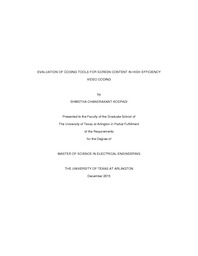
ATTENTION: The works hosted here are being migrated to a new repository that will consolidate resources, improve discoverability, and better show UTA's research impact on the global community. We will update authors as the migration progresses. Please see MavMatrix for more information.
Show simple item record
| dc.creator | Chandrakant Kodpadi, Shwetha | |
| dc.date.accessioned | 2016-01-26T22:57:12Z | |
| dc.date.available | 2016-01-26T22:57:12Z | |
| dc.date.created | 2015-12 | |
| dc.date.issued | 2015-12-03 | |
| dc.date.submitted | December 2015 | |
| dc.identifier.uri | http://hdl.handle.net/10106/25438 | |
| dc.description.abstract | High Efficiency Video Coding (HEVC) [1] is the latest Video Coding format. It challenges the state-of-the-art H.264/AVC [3] Video Coding standard which is in current use in the industry by being able to reduce the bit rate by 50% and retaining the same video quality. It came into existence in the early 2012 although Joint Collaborative Team on Video Coding (JCT-VC) was formed in January 2001 to carry out developments on HEVC, and ever since then a huge range of development has been going on. On 13 April 2013 [11], HEVC standard also called H.265 was approved by ITU-T, Joint Collaborative Team on Video Coding (JCTVC), a group of video coding experts from ITU-T Study Group (VCEG) and ISO/IEC JTC 1/SC 29/WG 11 (MPEG).
Coding of screen content video is becoming important because of applications such as wireless displays, graphics, remote desktop, remote gaming, automotive infotainment, cloud computing, distance education etc. Video in these applications often has mixed content consisting of natural video, text and graphics in the same picture. Coding of screen content, very high bit-rate and lossless coding, coding of auxiliary pictures (e.g., alpha transparency planes), and direct coding of RGB source content were included in HEVC Range Extensions (RExt) standard [20] and focused in HEVC SCC Extension.
As part of this thesis, SCM test model 5 is used as the latest Screen content model. Different coding tools and non-normative algorithms for screen content coding in HEVC Version1, HEVC-RExt and HEVC-SCC is explained in detail. Coding effieciency of the main Screen content coding tools, Intra block Copy, Palette mode, Adaptive Colour Transform are evaluated using SCM5.2. Further, the coding efficiency of HEVC16.6+SCM5.2 is evaluated against HEVC16.4+RExt and state of art H.264/AVC.
SCM with IBC gives bitrate savings from 5-45 %, SCM with PM gives 14-67 % and SCM with ACT gives 0.001 to 0038 % compared to SCM without IBC, without PM and without ACT, respectively. Also, SCM is evaluated against JM19.0 and HEVC-RExt. It can be seen that SCM gives bitrate saving of about 45 – 83 % compared to HEVC+RExt under lossless condition and 23 - 87% compared to JM19.0 (AVC) under lossless condition. Under lossy condition, SCM gives 57 – 81 % BD-bitrate savings compared to HEVC+RExt and 62 – 88 % BD-bitrate savings compared to JM19.0. | |
| dc.format.mimetype | application/pdf | |
| dc.language.iso | en_US | |
| dc.subject | HEVC | |
| dc.subject | Video coding | |
| dc.subject | Evaluation | |
| dc.title | EVALUATION OF CODING TOOLS FOR SCREEN CONTENT IN HIGH EFFICIENCY VIDEO CODING | |
| dc.type | Thesis | |
| dc.contributor.committeeMember | Rao, Kamisetty R. | |
| dc.contributor.committeeMember | Bredow, Jonathan W. | |
| dc.contributor.committeeMember | Alavi, Kambiz | |
| dc.date.updated | 2016-01-26T22:57:12Z | |
| thesis.degree.department | Electrical Engineering | |
| thesis.degree.grantor | The University of Texas at Arlington | |
| thesis.degree.level | Masters | |
| thesis.degree.name | Master of Science in Electrical Engineering | |
| dc.type.material | text | |
| dc.creator.orcid | 0000-0003-4225-3287 | |
Files in this item
- Name:
- CHANDRAKANTKODPADI-THESIS-2015.pdf
- Size:
- 2.014Mb
- Format:
- PDF
This item appears in the following Collection(s)
Show simple item record


